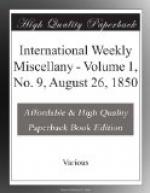“Why, so we can,” said Harry. “Only, instead of hooks and lines, we must use wires—two wires, one from one end, the other from the other, of a galvanic battery. Put the points of these wires into water, a little distance apart, and they instantly take the water to pieces. If they are of copper, or a metal that will rust easily, one of them begins to rust, and air-bubbles come up from the other. These bubbles are hydrogen. The other part of the water mixes with the end of the wire and makes rust. But if the wires are of gold, or a metal that does not rust easily, air-bubbles rise from the ends of both wires. Collect the bubbles from both wires in a tube, and fire them, and they turn to water again; and this water is exactly the same weight as the quantity that has been changed into the two gases. Now then, uncle, what should you think water was composed of?”
“Eh? well—I suppose of those very identical two gases, young gentleman.”
“Right, uncle. Recollect that the gas from one of the wires was hydrogen, the one-ninth of water. What should you guess the gas from the other wire to be?”
“Stop—eh?—wait a bit—eh?—oh! why, the other eight-ninths, to be sure.”
“Good again, uncle. Now this gas that is eight-ninths of water is the gas called oxygen that I mentioned just now. This is a very curious gas. It won’t burn in air at all itself, like gas from a lamp, but it has a wonderful power of making things burn that are lighted and put into it. If you fill a jar with it—”
“How do you manage that?” Mr. Bagges inquired.
“You fill the jar with water,” answered Harry, “and you stand it upside down in a vessel full of water too. Then you let bubbles of the gas up into the jar, and they turn out the water and take its place. Put a stopper in the neck of the jar, or hold a glass plate against the mouth of it, and you can take it out of the water and so have bottled oxygen. A lighted candle put into a jar of oxygen blazes up directly, and is consumed before you can say Jack Robinson. Charcoal burns away in it as fast, with beautiful bright sparks—phosphorus with a light that dazzles you to look at—and a piece of iron or steel just made red-hot at the end first, is burnt in oxygen quicker than a stick would be in common air. The experiment of burning things in oxygen beats any fire-works.”
“Oh, how jolly!” exclaimed Tom.
“Now we see, uncle,” Harry continued, “that water is hydrogen and oxygen united together, that water is got wherever hydrogen is burnt in common air, that a candle won’t burn without air, and that when a candle burns there is hydrogen in it burning, and forming water. Now, then, where does the hydrogen of the candle get the oxygen from, to turn into water with it?”
“From the air, eh?”
“Just so. I can’t stop to tell you of the other things which there is oxygen in, and the many beautiful and amusing ways of getting it. But as there is oxygen in the air, and as oxygen makes things burn at such a rate, perhaps you wonder why air does not make things burn as fast as oxygen. The reason is, that there is something else in the air that mixes with the oxygen and weakens it.”




